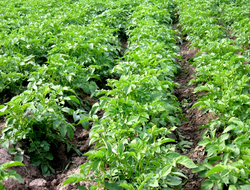The Potato: Nutrition in a Package
Published: January 25, 2021
The potato has been a dietary staple for diverse population groups for thousands of years.
This versatile starchy vegetable is a good source of carbohydrate, vitamins, minerals, and phytochemicals, and is an economical vegetable.
Despite its long history as a nutritious dietary staple, the potato's nutritional health value has been contested in recent years.
This is mostly due to the high glycemic index (GI) rating of potatoes.
A high GI rating means that the carbohydrate contained in a potato is rapidly digested and absorbed which results in a rapid rise in blood-glucose levels.
There is some concern that foods which cause a rapid rise in blood-glucose levels may increase the risk for type 2 diabetes,
These foods may also negatively affect blood-glucose control for people already diagnosed with type 2 diabetes.
However, research to date has not clarified the nutritional health position with respect to the connection between consuming potatoes and risk for type 2 diabetes.
There are suggestions that consuming potatoes results in being overweight or obese.
However, any connection between potato consumption and being overweight may be due to the way the potatoes are prepared, and the cooking method used, rather than the potato itself.
This article provides a historical background of the potato, the nutrient composition of the potato, and makes suggestions for preparing and serving potatoes to be advantageous to your health.
Historical Background
The potato is the starchy tuber of Solanum tuberosum, a perenenial of the Solanacae (nightshade) family and has been a dietary staple for thousands of years.
The many varieties of potatoes as we know them today, have originated from a single variety in Peru.
Domestication of potatoes is thought to have begun between 7,000 to 10,000 year ago.
Many centuries of selective breeding has resulted in more than 1000 varieties currently farmed in Peru and other areas of the Andes.
Potatoes, since their introduction to other parts of the world more than 400 years ago, have become the world's fourth largest food crop.
There are about 5,000 varieties worldwide, and are integral to the diets of many people around the world.
Potato plants are readily adapted to a diverse range of climates which provide a cool and moist environment for the growth of these starchy tubers.
A plant disease, Phytophthora infestans, led to catastrophic crop failures in Ireland during 1845: a period known as the Great...link to the full article to learn more.
References
1.
Wikipedia
2.
The Food Processor
3.
Halton et al. (2006). Potato and french fry consumption and risk of type 2 diabetes in women. American Journal of Clinical Nutrition, 83, 284-290

